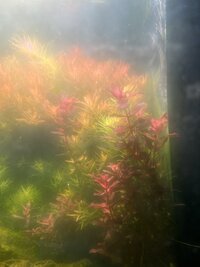If you just bought a tank, I’d say dose ferts on the bottle daily dose and send me a photo in a week.Not really lol - say I bought my first tank yesterday, how do I know if I have soft water or hard water? What if my water is kind of middling lol? What if I'm a tap water user, and my source water is softer in the winter (due to rain water run-off) than the summer?
🙂.
I'm playing devils advocate here of course, as I have no personal allegiance to any particular type of dosing, other than what I would recommend to a brand new planted tank owner - but in that one sentence you've introduced a plethora of variables and uncertainty which is exactly what a prescriptive system should aim to avoid for someone who has never even heard of dry ferts before.
When I was given this advice on my first ever tank, the words EI brought fourth a whole lot of stress 🤣. Because everyone goes down the rabbit hole when you “do EI” … people who don’t go down the rabbit hole always just dose the bottle.
Hehe. So what EI? To me, it’s a concept. You can dose 2 ppm NO3 and be in “EI state”.It's called the Estimative Index 😜
There again it depends on the user to some extent as to exactly what defines the sweet spot. I'm a maintenance-phobe, so the sweet spot for me is the point where I get clean plant growth and an algae free tank, with the minimum of trimming. 100 PAR at the substrate is beyond that point I'd say. You're shooting for perfect compact plant form, so your target might be higher..
You also have to be realistic on what can be achieved on the average tank. I think we can agree that something like a Chihiros Vivid II or ADA Solar RGB are some of the brightest commercial lights available. Place those 200-300mm above a 450mm deep tank, and you're probably not going to be hitting more than 200 PAR at the centre at substrate level, with the lights on full whack - so 600 PAR is completely unrealistic unless set up with multiple high output point source lights as you have done.
I had said to you before that high light means just turn your light that you buy to 100 and move on. That’s not that good. But everyone who buys any of these lights immediately runs it at 50. Why not just run your light at 100 and move on ?I also don't know many people that would argue that a Vivid II at 100% or a Solar RGB isn't high light?
ADA, Green aqua, aquaflora, IAPLC etc anyone I’ve read who does this commercially does the light at 100.
Maybe the commercially is the piece.
The argument for too much nutrients being an issue is the plant can take care of it. The argument for co2 being an issue is that (well it is very hard to put co2 in excess to causes issues 10lbs in under a week is nonsense).
So? Why not just give carte blanche light and let the plant “deal with it”.
all of your argument against it are bang on so I’ll see if I can draft a pros list.
Arguably, This is just as rediculous as dosing high column ferts for the sake of “making sure the plant has enough light”.
But people still dose EI when we all know it’s beyond overkill except in extremely hard water.
So in the UK, full EI is a great recommendation to a beginner. But when a USA comes on and reads that on one of the best forums for the hobby, and they Lard in EI in their moderate water (since most of USA is moderate/soft) and has issues, then that’s where the discrepancy lies.
So perhaps, we give recommendation by location and highest likelihood of water. But that sucks too. 45 minutes away, the water is GH 20 😂.
Last edited:












